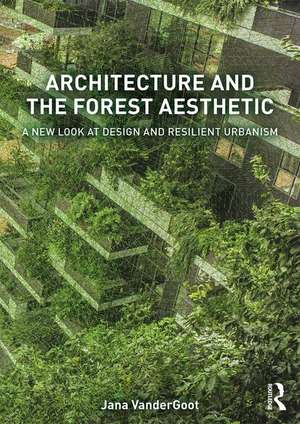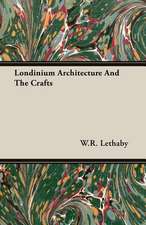Architecture and the Forest Aesthetic: A New Look at Design and Resilient Urbanism
Autor Jana VanderGooten Limba Engleză Paperback – 20 dec 2017
What is present here in Architecture and the Forest Aesthetic is both a review of many ingenious ways in which the forest aesthetic has already been expressed in design and urbanism, and an encouragement to further use the forest aesthetic in design language and design outcomes. Case study projects featured include the Chilotan building craft of Southern Chile, the yaki sugi of Japan, the Biltmore Forest in the Southeastern United States, the Australian capital city Canberra, Bosco Verticale in Milan, Italy, the Beijing Olympic Forest Park in China, and more.
| Toate formatele și edițiile | Preț | Express |
|---|---|---|
| Paperback (1) | 297.49 lei 3-5 săpt. | +26.85 lei 6-12 zile |
| Taylor & Francis – 20 dec 2017 | 297.49 lei 3-5 săpt. | +26.85 lei 6-12 zile |
| Hardback (1) | 825.21 lei 6-8 săpt. | |
| Taylor & Francis – 20 dec 2017 | 825.21 lei 6-8 săpt. |
Preț: 297.49 lei
Nou
Puncte Express: 446
Preț estimativ în valută:
56.94€ • 59.22$ • 47.72£
56.94€ • 59.22$ • 47.72£
Carte disponibilă
Livrare economică 21 februarie-07 martie
Livrare express 06-12 februarie pentru 36.84 lei
Preluare comenzi: 021 569.72.76
Specificații
ISBN-13: 9781138837744
ISBN-10: 1138837741
Pagini: 292
Ilustrații: 99 Line drawings, color; 127 Halftones, color
Dimensiuni: 174 x 246 x 18 mm
Greutate: 0.56 kg
Ediția:1
Editura: Taylor & Francis
Colecția Routledge
Locul publicării:Oxford, United Kingdom
ISBN-10: 1138837741
Pagini: 292
Ilustrații: 99 Line drawings, color; 127 Halftones, color
Dimensiuni: 174 x 246 x 18 mm
Greutate: 0.56 kg
Ediția:1
Editura: Taylor & Francis
Colecția Routledge
Locul publicării:Oxford, United Kingdom
Public țintă
ProfessionalCuprins
INTRODUCTION Part 1 BUILT IN WOOD 1. The Wood Cycle: Plyscrapers and the Cross-Laminated Timber Panel 2. Transposing the Forest: Gothic Cathedrals in Northern France 3. The Design and Make Forest at Hooke Park 4. Fitzroya Architecture: Chiloé Archipelago Churches in Southern Chile Part 2 DECOMPOSITION 1. Char After Burn: Pyromenon of the Boreal Forest 2. Mycelium Bricks: Hy-Fi in New York City Part 3 COLLECTIVE SPACE IN A FIELD 1. Table in Rome II: Forest as Forum 2. Dehesa and the Mosque-Cathedral of Córdoba in Spain 3. Constructed Succession: Afterlife at the Beijing Olympic Forest Park Part 4 FORESTRY CULTURES 1. Hand-over Urbanism: Future Library 2. Logging: DUX and the Fascist Ritorno all’Ordine in Italy Part 5 TECHNOLOGY AND THE FOREST ARCHIVE 1. Harvard Forest Timelapse 2. Instant City and the Cybernetic Forest Part 6 TREED INFRASTRUCTURE 1. Treed Infrastructure: The Performance of Planting in Canberra 2. Woodlot Urbanism: Hantz Woodlands in Detroit 3. Waterlogging: Amsterdam and its Bos 4. Low Density Recipe: Tree City at Downsview Park Part 7 HUMAN FOREST BIOSYSTEMS 1. A Vertical Forest Biosystem in the Human Forest Biome 2. Krummholz Design in West Loop 3. Spontaneous Ornament: Hundertwasser and the Tree Tenant
Descriere
Architecture and the Forestry Aesthetic presents forestry as a radical tool for re-imagining architecture and sustainable cities. This book shows you how forestry is a design language, an approach to aesthetics, inspired by permeable floors, protective canopies, connected food chains, and resilient ecological, social, and economic systems. Thirty speculative, historical, and contemporary case studies in eighteen countries on five continents are illustrated with more than 300 images to help you apply the lessons learned to your own work. Also includes essays by Charles Waldeim and Elizabeth Meyer, a glossary, and further reading.
















